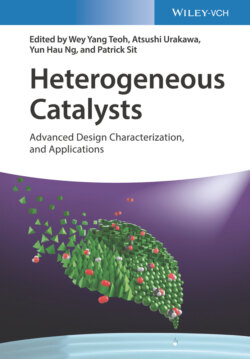Читать книгу Heterogeneous Catalysts - Группа авторов - Страница 54
4.3 Emerging Techniques for Carbon‐Based Catalyst Synthesis
ОглавлениеFigure 4.5 displays some of the most relevant techniques for the preparation of metal catalyst on carbon supports. One of the core objectives is to produce metal catalysts of uniform and defined particle size, whether as single atoms, clusters, or nanoparticles. It has been recognized recently that SACs provide higher activity and selectivity in several catalytic reactions that involve small molecules such as oxygen reduction, hydrogen evolution, methane activation, CO2 reduction, CO oxidation, or organic synthesis among others (see Chapter 6). Likewise, there are reactions that require large ensembles of atoms or nanoparticles. For example, cobalt catalyst size 5–6 nm is required for Fischer–Tropsch synthesis (FTS) to achieve optimum activity and selectivity toward large‐chain hydrocarbons [41]. The deposition of presynthesized colloidal nanoparticles of well‐defined size and compositions on carbon supports with controlled interparticle distances is a major challenge that will be addressed below. The goal is to enable catalyst engineering with close to atomic‐scale precision to enable efficient heterogeneous reactions.
Figure 4.5 Relevant techniques optimized to prepare engineered catalysts on carbon materials.
